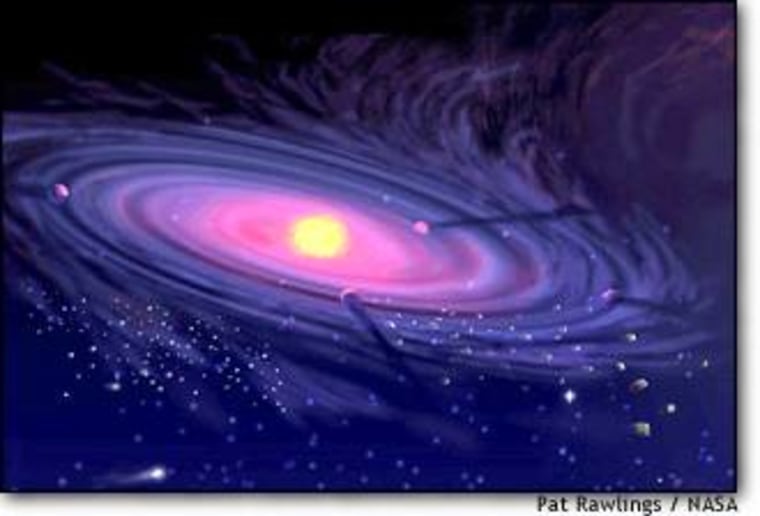Spring is springing in the Northern Hemisphere. Fall is falling in the south — all because of Earth’s tilt and orbit. We often take our planet’s spin for granted, but some of the more peculiar side effects just might make your head spin, too.
For example, if you want to lose weight without giving up the ice cream and pizza, head for the equator. Because the earth is spinning at 1,040 mph (1,664 kilometers per hour), the centrifugal effect at the equator counteracts enough of gravity’s pull that a person weighing 150.8 pounds (68.5 kilograms) at the poles, comes in at a svelte 150 pounds (68.2 kilograms) on the equator.
Theres another effect at work that tends to lighten you up a tiny bit more. Some of the centrifugal force from Earth’s spin acts on the planet itself and causes the planet to flatten out a little. The earth is not perfectly round. It’s wider across the middle than it is top to bottom. A person standing on the equator is 13 miles farther from the center of the earth than a person at the poles. The further you are from the center of a mass, the less gravitational pull it exerts on you.
This equatorial weight loss program is not, however, sufficient to make up for that last serving of lasagna.
The origin of spin
N.F. of Boston asks a good question about the spinning planets: “Why do they keep spinning?”
Planets likely formed when particles of dust in post-Big Bang space either collided or were drawn together by gravity, the bigger particles pulling in the smaller. As the pieces were drawn in from space, they arrived and joined the growing mass at different angles.
That’s how the spin of planets got started. Then, as gravity made everything condense, the spin sped up, just like what happens when a spinning ice skater pulls in her arms.
But planets spin at different speeds, for two reasons: First, the material joining each growing planet was moving in different ways and at different speeds. Second, each planet ended up with a different mass. Like bigger or smaller skaters, they all spin at different speeds.
Standing on the equator of Mercury, you’d be traveling a wimpy 7 mph. On Venus you’d be going even slower, just 4 mph. You’re zipping along at 1,040 mph on Earth, 538 mph on Mars, an incredible 28,262 mph on Jupiter, 22,994 on Saturn, 5,544 on Uranus, 5,143 on Neptune, and 29 mph on Pluto.
Remember that flying debris coming in at all sorts of angles that got planets spinning in the first place? That’s why Venus, Mercury, and Pluto spin backward. They rotate retrograde, east to west instead of west to east. Then there’s Uranus, spinning on its side, with its pole going left to right instead of up and down (relative to the other planets, that is) — probably because something hit it that was big enough to rotate the whole planet 90 degrees.
If your head isn’t spinning yet, try this one: The speed of the planet’s spin is changing all the time, altered by the gravitational pull from the sun, the other planets and their moons. The earth is spinning slower and slower. Tomorrow will be longer than yesterday.
Here’s how it works: The moon pulls the surface of the oceans up. The rise and fall of the ocean surface, the oceanic tide, creates a friction between the surface and the ocean bottom, which the moon isn’t pulling up and down as much.
The moon doesn’t just pull on the 70 percent of the earth that’s covered with ocean. The solid surface of the earth, the crust, also goes up and down because of gravitational pull from other celestial objects. Tom Herring, a geophysicist at the Massachusetts Institute of Technology, says Boston rises and falls nearly 8 inches a day.
“Fortunately,” he adds, “so does everywhere else.”
Eighty percent of that crustal tide is from the pull of the moon. Twenty percent is from the pull of the sun — which, although it’s much farther away, is still big enough to exert a tidal tug on Earth. The rise and fall of Earth’s outer crust creates a tugging on the inner mantle layer, and that slows us down, too.
The great slowdown
Over time, this can add up to a lot of time. Scientists estimate that when the moon formed billions of years ago and started to slow the earth down, a full day — the time for one complete revolution of Earth’s axis — was just 5.5 hours long.
We’re not done slowing down, either. The day gets longer by about one second each year, according to Herring. But it’s not the same precise change each year, because Earth’s spin varies a little each year. So instead of measuring days, minutes and seconds based on the time between one sunrise and the next, timekeepers in the 1950s created the more precise “atomic” second, the time it takes for a certain number of oscillations of a cesium atom. They tried to match the atomic second to one-86,400th of the solar day.
The day has grown longer by 32 leap seconds in the last 50 years or so. By the middle of the next century, Herring says, the slowing down of Earth’s rotation will require a leap second every few months. And five or six decades from now, the atomic second will have to be adjusted as well. Timekeepers will have to pick a bigger number of oscillations of the cesium atom, so that the atomic second will stay matched with one second on the 24-hour solar clock — one-86,400th of our ever-longer day.
David Ropeik is a longtime science journalist and currently serves as director of Risk Communication at the Harvard Center for Risk Analysis. This article is drawn from the archives of “How and Why,” Ropeik’s column about scientific puzzlers.
